
by Timothy Oleson Tuesday, September 12, 2017
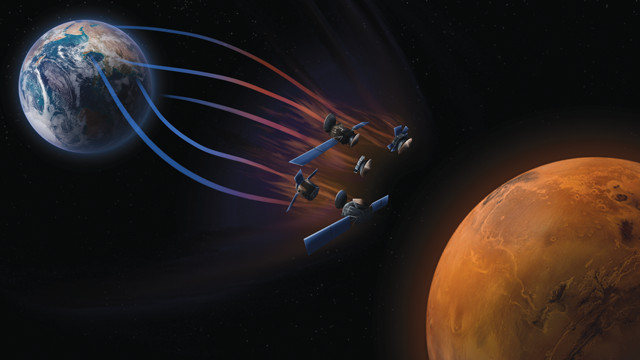
Credit: K. Cantner, AGI.
About every 26 months, the positions of Earth and Mars in their respective orbits align for a few weeks such that spacecraft can take the shortest possible route to the Red Planet. A shorter trip means less fuel — and consequently less mass — to carry, as well as less time for mishaps to occur in transit. These are compelling factors for cost- and weight-conscious mission planners, so it’s during these brief, roughly biennial launch windows that space agencies have typically sent spacecraft to Mars.
Recent launch windows have seen, on average, just one to two missions depart for Mars (see table, Recent and Upcoming Mars Missions by Launch Window). This coming spring, NASA will send another two, both aboard the same rocket: the Mars interior-scanning InSight lander, as well as Mars Cube One, which consists of a pair of briefcase-sized cubesats designed to relay data about InSight’s landing as they fly by Mars.
In contrast to the modest pace of late, as many as five or six Mars missions might launch in late July or early August 2020. These missions include efforts from a variety of space agencies around the world — and possibly a private corporation for the first time — some with prior experience in Mars exploration and some without.
The exact timing for each launch, and the sequence in which they’ll go, are not yet set. Indeed, whether they will all be ready in time for the window — which, at less than three years away, is not far off on the timescales of interplanetary mission development — isn’t clear. Regardless, the group of missions targeting a summer 2020 departure represents a growing and increasingly diverse interest in interplanetary space exploration. With many eyes looking toward future programs to return samples from Mars — and, ultimately, to send humans there — this proliferation of interest and expertise, together with specific technical innovations designed into some of the would-be 2020 missions, may shape the trajectory of Mars exploration in the decades to come.
The group of missions slated to launch in 2020, some of which involve multiple components, includes at least two rovers (with as many as four possible), up to four stationary surface landers and three orbiters.
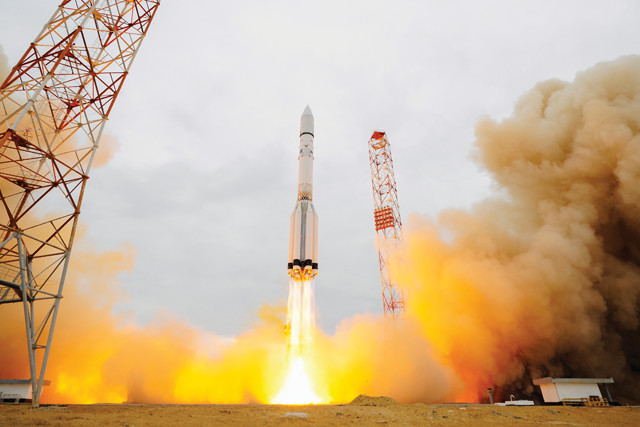
A Russian Proton-M rocket carrying the joint ESA-Roscosmos ExoMars 2016 mission lifts off from Baikonur Cosmodrome in Kazakhstan on March 14, 2016. The agencies plan to launch the second half of the ExoMars mission from Baikonur in July 2020. Credit: ESA-Stephane Corvaja, 2016.
The two best publicized missions are NASA’s 2020 Rover and the joint European Space Agency (ESA)/Russian Space Agency (Roscosmos) ExoMars 2020. Each features a six-wheeled mobile science lab designed to image, collect and analyze rocks and soils while also running atmospheric and environmental studies. The design — and anticipated delivery via skycrane — of NASA’s upcoming rover largely duplicates that of the Mars Science Laboratory (MSL), aka Curiosity, although it will be equipped with new navigational tools to aid in entry, descent and landing as well as an updated suite of instruments.
ExoMars 2020 is the second half of the two-part ExoMars program and follows the successful delivery of the Trace Gas Orbiter (TGO) in 2016, which is meant to sniff out faint signs of methane and other gases in the atmosphere. The Schiaparelli lander, sent in tandem with TGO, crashed to Mars’ surface after suffering navigation errors that caused its computer to prematurely release its parachute and prevented its thrusters from operating correctly. In addition to a rover, ExoMars 2020 includes a heavily instrumented surface lander intended to study the climate, subsurface and ground-atmosphere interactions.
With its orbiter, named “Hope,” the United Arab Emirates (UAE) aims to send the first Arab-led mission to Mars. The orbiter will carry cameras and spectrometers to study gas escaping from Mars’ atmosphere. The UAE Space Agency says the craft will also be Mars’ “first true weather satellite,” monitoring daily and seasonal weather and climate, and investigating how these are affected by topography and interactions among different atmospheric layers. In developing the Hope mission, the young agency — created in late 2014 — has signed agreements with France, Kazakhstan, Russia, the U.K. and the U.S., pledging cooperation and data sharing. And an agreement with Japan should see Hope launched from that country’s Tanegashima Space Center.
Missions from China and India are also possible, although the countries’ respective space agencies have not shared much information publicly about these efforts. China, whose ambitions in space have grown rapidly of late with a series of missions to the moon along with satellites studying quantum communications and other phenomena, offered some details last year about its second Mars attempt. The aspiring 2020 mission is meant to include a trio of probes: an orbiter, lander and rover. The latter will be designed to last three Martian months and carry “13 payloads, including a remote sensing camera and a ground penetrating radar, which could be used to study the soil, environment and atmosphere of Mars, as well as the planet’s physical fields, the distribution of water and ice, and its inner structure,” according to China’s state-sponsored Xinhua News Agency.
After India’s success in reaching Mars in 2014 on its first attempt with the Mars Orbiter Mission (MOM) — tempered partially by an ill-designed methane sensor — the Indian Space Research Organization (ISRO) is considering a follow-up mission, reportedly with France’s help, but details are scant. The agency issued an “Announcement of Opportunity” seeking proposals from Indian researchers by the end of last summer for instruments to fly on “MOM-2.” The announcement stated that “it is now planned to have the next orbiter mission around Mars for a future launch opportunity,” but did not specify a date. ISRO is said to be considering a lander and/or rover for the mission as well, and to be interested in returning to Mars as early as 2021, which would mean launching in 2020. The mission budget was reportedly approved last winter.
A 2020 mission from California-based SpaceX, which would be the first privately funded and planned effort, appears to be the most tenuous at this point. The “Red Dragon” mission, hotly anticipated since it was first announced in 2016, was to repurpose the company’s Dragon 2 craft — currently in development as a crew transport for NASA — as a Mars lander. The first incarnation of the Dragon capsule has been ferrying supplies to and from the International Space Station since 2012, and Red Dragon was intended as the first major step toward SpaceX’s long-term goal of ferrying passengers to the Red Planet. Before carrying people, however, the modified Dragon 2 landers could also be used for flight testing and carrying heavy equipment in support of early human explorations. The main goal of a 2020 mission would be to demonstrate supersonic retropropulsion, a landing technology employing powerful braking thrusters to decelerate a spacecraft too large to be slowed by the airbags, parachutes and skycranes used in the past. Speaking at a space conference in July, however, SpaceX CEO Elon Musk said the company no longer plans to use such thrusters on the Dragon 2, and that the retropropulsion technique originally envisioned no longer seemed like the right approach for a Mars landing, comments that suggest the prospects of a SpaceX Mars mission in 2020 are slim.
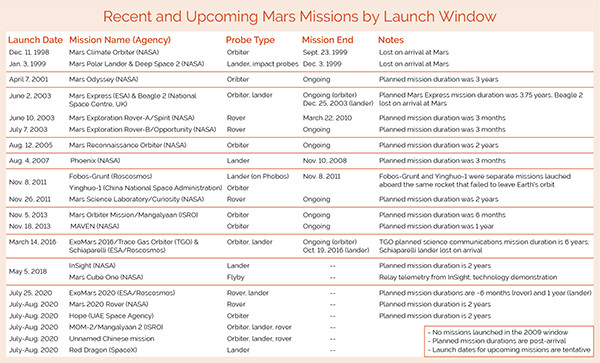
With so many missions eyeing the 2020 launch window, it could seem that they’ve been planned collaboratively to advance international Mars exploration. But that’s not the case. Likewise, the fact that environmental conditions on Mars when the spacecraft arrive in 2021 should be relatively favorable (see sidebar, A Great Time to Land on Mars ) — a boon for surface missions in particular — has not driven the uptick of Mars missions. Rather, “it’s somewhat of an accident that there’s this whole mission queue in a particular window,” says John Logsdon, emeritus professor at George Washington University’s Space Policy Institute.
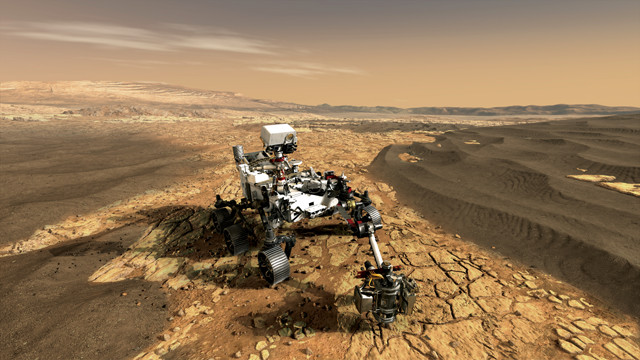
The design of NASA's 2020 rover, shown here in an artist's concept, largely duplicates that of Curiosity, although it will be equipped with an updated suite of instruments to study Mars' geology and climate, and to search for biosignatures. Credit: NASA/JPL-Caltech.
For NASA, 2020 has always been the goal for its next rover once the agency settled in late 2012 on the idea of sending a Curiosity lookalike. (Curiosity itself took roughly eight years from conception to launch.) The UAE, noting that a 2021 arrival would coincide with the country’s 50th birthday, has also eyed the 2020 window since announcing its mission in 2014.
For others, though, 2020 wasn’t the first choice: ExoMars’ second installment was previously scheduled to launch in 2018, and SpaceX’s initial plan for Red Dragon also called for a 2018 launch. The 2020 timing for China and India — both of which appear to be developing their Mars missions on compressed time lines, at least by NASA or ESA standards — may partly reflect what some observers see as an emerging space race in Asia.
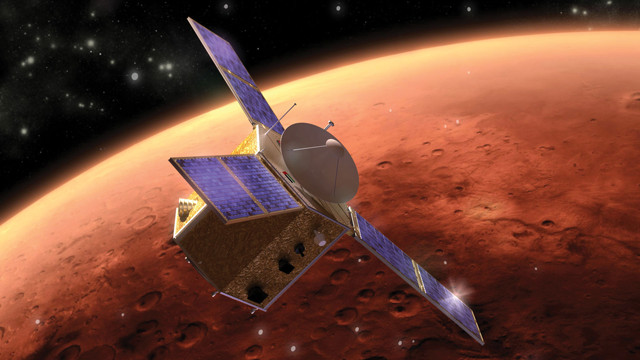
If successful, the United Arab Emirates' "Hope" orbiter will be the first Arab-led Mars mission. Credit: ©UAE Space Agency/Mohammed Bin Rashid Space Center.
Nonetheless, Logsdon says, the sizable group of missions demonstrates the growing popularity of Mars internationally, and reflects a combination of factors: “that Mars has been a high-priority exploratory destination for the U.S., Europe and Russia; and that new entrants into exploration, like the UAE and India, find it more fascinating than going to the moon.” China, meanwhile, “is building on its moon program … so Mars becomes the next logical place to go,” he says.
“All space-faring nations regard Mars as both a very interesting target and a sort of a badge of prestige,” says Jorge Vago, ESA’s ExoMars 2020 project scientist. Regardless of the various motivations for each of the missions, “it’s a happy confluence of interests in many places that so many missions are slated to launch in 2020,” Vago says. “It’s going to be busy times.”
Most of the 2020 missions are motivated, at least partially, by the goal of improving our fundamental physical understanding of Mars, especially about the planet’s surface geology, internal workings, water, climate and habitability. The spacecraft will arrive armed with arrays of cameras, sensors and instruments to image and analyze the planet above- and belowground. NASA’s 2020 rover and ExoMars 2020 are also explicitly focused on searching for biosignatures: chemical and mineralogical features in the rock record that could represent residual bits of past life.
Searching out organic compounds is key to identifying potential biosignatures. But simply finding organics, which are also formed abiotically and can be transported through space via asteroids or comets, doesn’t mean there was life. “You need something more to tell you that it’s a biosignature,” says Ken Farley, a geochemist at Caltech and the Mars 2020 rover project scientist. “One of the important ways to do that is looking at how [organic matter] is distributed within a rock,” he says. Life tends to concentrate organic matter in characteristic ways, whereas material delivered from space is apt to be more evenly distributed in rock and soil. Life also tends to concentrate certain other elements, like iron. Looking at rock samples on Mars, Farley says, “a really compelling biosignature for us to find would be concentrations of elements [important for life] and concentrations of organics that are correlated with each other.”
The main tool aboard NASA’s 2020 rover that will directly search for biosignatures is called SHERLOC (Scanning Habitable Environments with Raman and Luminescence for Organics and Chemicals). SHERLOC combines a camera, UV laser and spectrometer to scan tiny patches of rock, simultaneously detecting the types and distribution of organic matter present as well as minerals and elements of interest. The instrument package offers an advantage over Curiosity’s organics analyzer, the SAM (Sample Analysis at Mars) instrument suite, in that SHERLOC doesn’t require contact with the sample, thus reducing the chances of damaging or contaminating native organic material.
Meanwhile, aboard the ExoMars rover will be an instrument named MOMA (Mars Organic Molecule Analyzer). MOMA can analyze powdered rock or soil samples in two ways. With the first technique — similar in concept to how SAM works — samples are oven-heated to separate volatile organics from inorganics; the resulting gas is run through a chromatograph and a mass spectrometer to separate and identify different molecules. Using this method, MOMA operators can also conduct chirality tests on certain types of molecules to determine whether they are “right-handed” or “left-handed” (the orientation of biologically produced chiral molecules on Earth), which could help distinguish biotic versus abiotic origins.
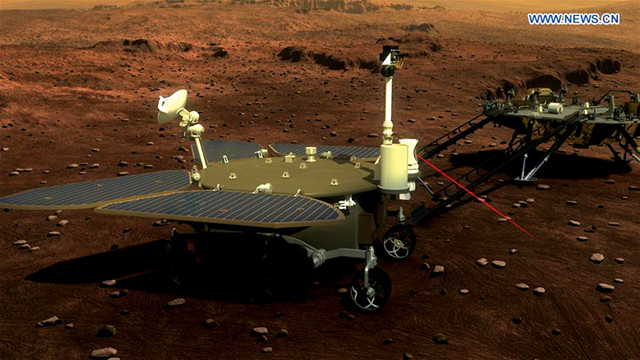
China's 2020 Mars mission will reportedly consist of a rover and lander — seen together in this artist's rendering — as well as an orbiter. Credit: Xinhua.
The second MOMA technique uses a UV laser to very rapidly heat samples and separate organic materials, which are then analyzed in the mass spectrometer. This is designed to circumvent the problems that Curiosity encountered with the perchlorate salts abundant in Martian soils. When heated, perchlorates become very powerful oxidants that can react with and break down organic molecules into smaller chlorinated compounds like chloromethane, Vago says. This has complicated efforts to interpret the organic materials Curiosity has detected, as the perchlorates alter the composition of the organics and obscure information about their origins. “The beauty of [MOMA’s] UV laser is that the deposition of energy is so fast that the perchlorates don’t get enough time to activate, so you can actually extract the organics before [the perchlorates] mess them up,” Vago says.
Another ExoMars tool that may help in the search for signs of past life is the rover’s drill. Whereas the drills aboard NASA’s Curiosity and 2020 rovers pull samples from the top several centimeters below the surface, ExoMars’ drill is designed to reach down as much as 2 meters underground. “We hope that that will gain us access to biosignatures in a better state of chemical preservation,” protected from the cosmic radiation that, due to Mars’ weak magnetic field and thin atmosphere, bathes the planet’s surface, Vago says. Over long periods of time, this radiation degrades organic matter, further complicating attempts to discern whether material might have had a biological origin.
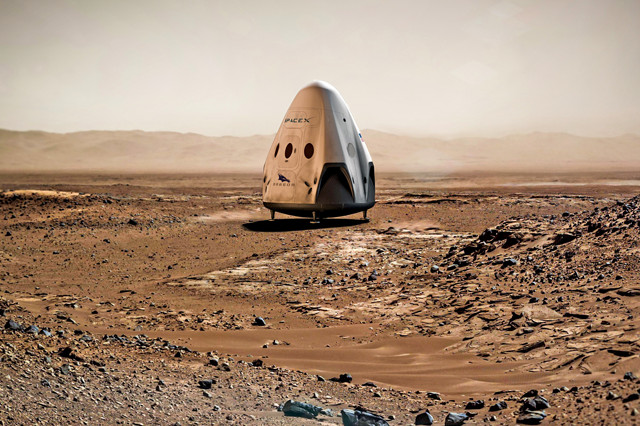
For its "Red Dragon" mission, SpaceX planned to repurpose its Dragon 2 module — currently in development as a crew transport for NASA — as a Mars lander, although the odds of the mission now appear slim. Credit: SpaceX.
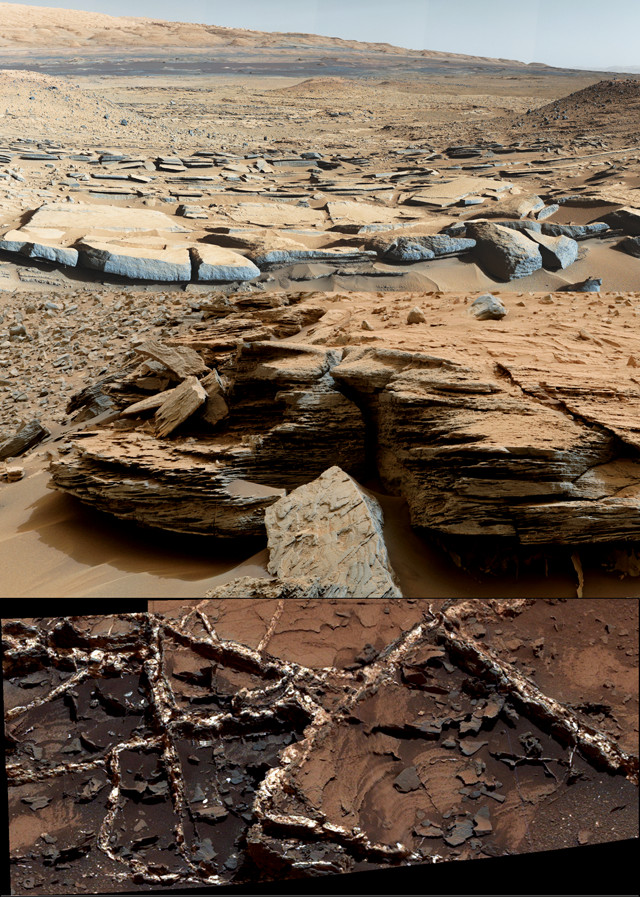
Exploring Gale Crater at different scales, NASA's Curiosity rover has found abundant evidence of habitable conditions, including flowing liquid water, on Mars' ancient surface: Right: Rock strata dip toward the base of Mount Sharp, suggesting flow of water toward a basin. Opposite page (left): Cross-bedding is seen in lithified sands in the Pahrump Hills. Opposite page (right): Fluid-deposited mineral veins cut across older rock at the Garden City site. Credit: right: NASA/JPL-Caltech; opposite page: both: NASA/JPL-Caltech/MSSS.
Another major factor in the search for biosignatures is where the rovers end up landing. The NASA 2020 rover team is evaluating three remaining candidate locations — two in the northern hemisphere, as well as one in the southern hemisphere, the Columbia Hills, where the Spirit rover previously explored — with a final decision expected in summer or fall 2018, Farley says. The ExoMars team, meanwhile, is still considering two northern hemisphere sites apart from NASA’s options.
Finding a location where the topography, altitude and climate are amenable to successful spacecraft landings is vital. But to increase the odds of finding potential life, the goal is to select an area where sediments were deposited in a watery environment roughly 3.5 billion to 4 billion years ago, when Mars is thought to have had a thicker atmosphere and a more temperate, Earth-like climate. Ideally, after deposition, these sediments would have been covered under layers — hundreds to thousands of meters thick — of cap rock or soil, called overburden, before then being mostly or completely unburied by impact- or wind-driven erosion relatively recently in Mars’ history. Each of the NASA and ExoMars candidate sites feature unique characteristics and challenges, although all meet these fundamental criteria.
The idea is that the overburden “would have afforded an added level of protection,” Vago says, so that any long-buried organic material would only have been exposed to cosmic radiation for a few hundred million years, say, instead of billions of years. “That’s the strategy to try to get the best possible molecular biosignatures,” he says, perhaps including relatively hardy molecules like lipids, the main component in cell membranes.
Whichever sites are chosen for the rovers, scientists will “wind up looking at a rock record that does not exist on Earth,” Farley says, which is one of the most appealing aspects of the missions. On Earth, very little rock older than 3.5 billion years is preserved because most of it has been recycled through erosion and plate tectonics. But “a large fraction of those rocks are preserved on the surface of Mars,” he says. “And so by going to Mars, we can actually learn about what a terrestrial planet looked like in its earliest history,” and also perhaps learn about the sorts of environments where life might have originated on our planet.
Beyond the horizon of the 2020 missions and the search for biosignatures lie two other lofty and longstanding Red Planet objectives: returning rock and soil samples to Earth, and, eventually, sending humans to explore Mars in person. These goals have been stated and reiterated by space agencies, planetary scientists and space enthusiasts for decades, including in a NASA authorization bill signed by President Trump in March that reaffirmed the agency’s goal of sending humans to Mars in the 2030s.
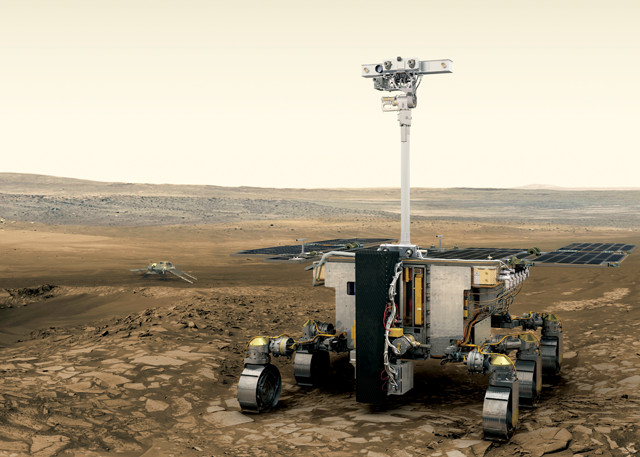
The solar-powered ExoMars 2020 rover (foreground) and stationary surface platform are shown in this artist's drawing. The rover's drill, designed to reach as far as 2 meters belowground, is housed in the tall cylindrical tube (dark gray) at the front of the probe. Credit: ESA/ATG medialab.
Past missions, particularly landers, have collected valuable data related to entry, descent and landing through the atmosphere, as well as weather and radiation conditions at the surface, all of which could broadly inform more ambitious sample return or manned missions. To date, though, little headway has been made in directly addressing the particular challenges of these missions. Some of the 2020 efforts, if successful, may change this.
In addition to continuing studies of weather and entry, descent and landing conditions, one of the main tasks for NASA’s 2020 rover will be to not only drill and analyze rocks, as Curiosity did, but also to stow, or cache, up to about 30 15-gram samples in secure containers that could be retrieved and returned to Earth by a future mission. Although both NASA’s rover and the ExoMars rover are equipped with sensitive instrumentation for hunting for signs of life, remotely determining whether a biosignature on Mars represents unequivocal evidence of extraterrestrial life would be extremely difficult, and likely controversial. “The reality is that the burden of proof for the detection of life outside of Earth is enormously high, and it’s unlikely that the instruments we have on board will overcome that burden,” Farley says. “By bringing samples back to Earth, we can apply the whole arsenal of instrumentation that exists on Earth in terrestrial laboratories to answer that question, as well as many other questions.”
ExoMars is not set up to cache samples, but, rather, to figure out where the most interesting and enlightening rocks might be located for a future sample-return mission to retrieve, Vago says. “Mars sample return is a complex mission; it’s an expensive mission,” he says, so it’s not guaranteed to happen often, or at all, without broad support. What’s needed is a “discovery to catalyze” that support, he says: “something that is so interesting that we would want to return samples to Earth for analysis.” In trying to find that key discovery, he says, ExoMars is a link “in the chain toward Mars sample return.”
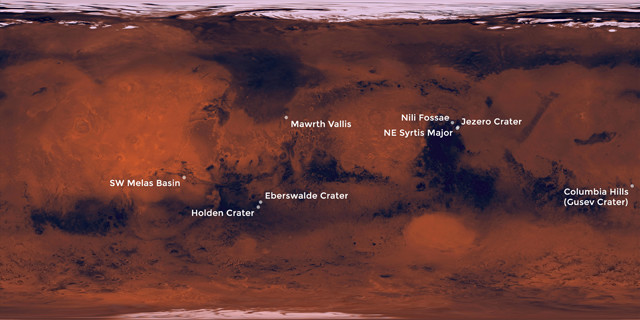
NASA is evaluating three candidate landing sites for its 2020 rover: Jezero Crater and NE Syrtis Major in the northern hemisphere and the Columbia Hills in the southern hemisphere. The ExoMars team is considering two sites: Mawrth Vallis and, just southwest of there, Oxia Planum (not shown). Credit: NASA.
In addition to catalyzing interest, and funding, for sample return and manned missions, numerous technological hurdles must be overcome before these goals are achieved. For instance, the means to launch a spacecraft off the surface of Mars does not yet exist. Carrying the tens of tons of fuel needed for a return trip back to Earth — to return cached samples or humans — would be hugely taxing for a Mars-bound spacecraft, so the idea of remotely producing fuel on Mars holds distinct appeal.
“MOXIE is really the big step forward” in this regard, Farley says. Unlike SHERLOC and the other main instrument payloads on NASA’s 2020 rover, which are all largely motivated by scientific questions, MOXIE (Mars OXygen In-situ resource utilization Experiment) is a technology demonstration of a system that generates oxygen from Mars’ carbon dioxide-rich atmosphere (see sidebar, Making Oxygen with MOXIE ). This oxygen, combined with methane most likely, could serve as the main ingredient in rocket fuel; and further down the line could provide breathing oxygen for human explorers stationed on the planet.
MOXIE “is basically fuel-cell technology run backward,” says Michael Hecht, a planetary scientist at MIT’s Haystack Observatory and MOXIE principal investigator. In a typical fuel cell, oxygen would be combined with fuel to produce electricity, with carbon dioxide as a byproduct. With MOXIE, Hecht says, “we start with carbon dioxide and energy [from the rover’s power source], and we get out carbon monoxide and oxygen.”
Hecht, along with many others, has closely followed news of SpaceX’s Red Dragon mission, in part, he says, because “it has something in common with MOXIE in that it’s taking a very substantial technology step toward a human landing.” The company has already demonstrated the use of powered descent systems to land its Falcon 9 rockets back on Earth for reuse, and during those landing tests, it had also reportedly conducted retropropulsion experiments at high altitude, where Earth’s atmosphere is similar in density to Mars’. A successful trial of supersonic retropropulsion on Mars would be “a huge step,” proving we can deliver the heavy equipment needed for settlements to the surface, Hecht says. And before that, the technology could be used to help carry “a small load of bricks off the surface and bring it home so we can study Mars in laboratories.”
However, unless SpaceX reinstates the thruster-equipped Red Dragon mission soon, it appears that the trial will have to wait, and perhaps be led by someone else. Supersonic retropropulsion has long been a goal for NASA, and an information-sharing agreement with SpaceX provided the agency with valuable flight-test data in recent years. It remains to be seen if NASA will accelerate its own program to develop the technology, or if other options are available.
With missions taking years to plan and facing limited launch opportunities, frequent delays and a historically high rate of failure, milestones in Mars exploration are difficult to predict. The failure of NASA’s Mars Climate Orbiter and Mars Polar Lander upon arrival at the planet in 1999, for example, was a major setback for the agency’s Mars Exploration Program. “Everything ground to a halt,” Hecht says, and the planned Mars Surveyor 2001 Lander, similar in design to the polar lander, was canceled. After those failures, however, NASA redeveloped its Mars strategy, calling for more integration among the goals and capabilities of individual missions. And out of that effort came the “enormously successful” Mars Exploration Rover tandem of Spirit and Opportunity, he says, which set the stage for Curiosity and the 2020 rover.
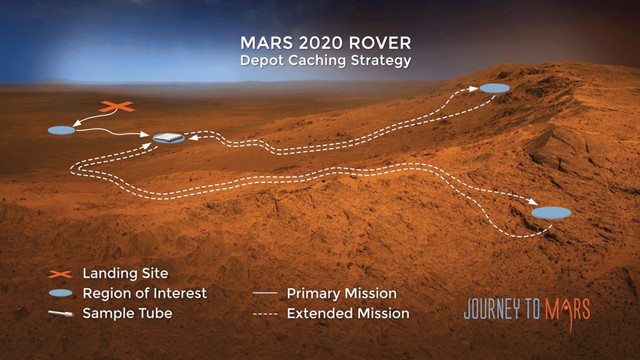
One of the main tasks for NASA's 2020 rover will be to stow, or cache, rock samples in secure containers that could be retrieved and returned to Earth by a future mission. Credit: NASA/JPL-Caltech.
o could the class of 2020 lead to a similar leap forward in Mars exploration?
While some of the missions will “push the envelope” technologically, Logsdon says, others are addressing simpler questions that are not as “central to planning for human expeditions to Mars.” (That’s not meant as a slight, he notes, just a reality given that the agencies behind them are new to interplanetary exploration.) But for nations new to space-faring, like China, India and the UAE, the sense of national accomplishment that may come with successfully putting a craft in orbit around, or on, Mars could spur interest in further Red Planet exploration.
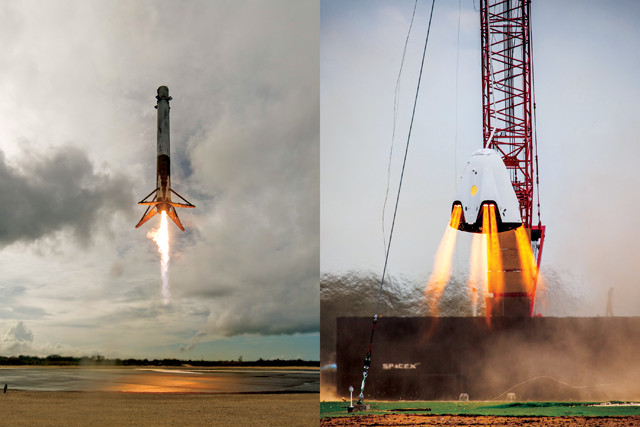
Left: The first stage of a SpaceX Falcon 9 rocket lands under a powered descent after launching a Dragon capsule toward the International Space Station in June. Right: A Dragon 2 capsule, hanging from cables attached to a crane, undergoes a test of its retropropulsion braking system in 2015. This past July, SpaceX CEO Elon Musk announced the company no longer planned to use the braking system on the Dragon 2. Credit: both: SpaceX.
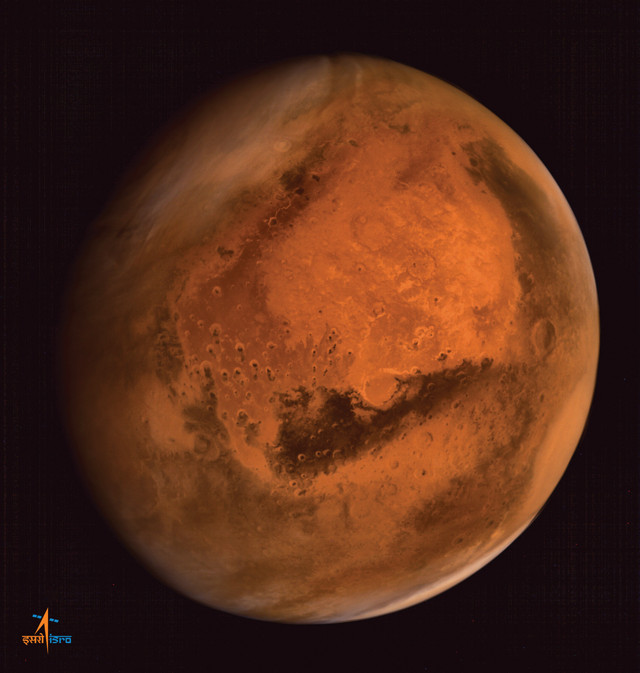
A dust storm covers part of Mars' northern hemisphere in this image captured by India's Mars Orbiter Mission (MOM), which reached the planet in 2014. The country is planning a follow-up mission, tentatively dubbed MOM-2. Credit: ISRO.
And regardless of whether all of the 2020 missions are successful, with more nations and even private interests now vying for Mars, the pool of expertise in designing, planning and executing missions is growing, and competition could spur innovation. “Opinions will differ,” Hecht says, but “I see enormous significance” in the fact that there are so many diverse missions attempting to reach Mars. There’s “a sense of urgency that’s created by the fact that if we don’t go there, someone else is going to,” he says.
But what happens next, after the upcoming missions? When it comes to what these missions might lead to in the future, “my basic answer is it’s not clear,” Logsdon says. Returning samples and sending humans to Mars are goals, not strategies, he says, adding that neither the U.S. nor Europe has a detailed strategy to follow up the 2020 missions.
This isn’t the only hurdle for ongoing exploration efforts. Sustaining the political and programmatic will to enable long-range planning and carry out increasingly ambitious missions is challenging. And there’s growing concern that a shortage of communications and data transfer capacity could occur if the Mars Reconnaissance Orbiter, TGO and other orbiters that serve as relays for surface probes aren’t replaced or supplemented in the near future. (Surface missions can communicate independently with Earth without orbital relays, but the transmission capacity is greatly reduced.) There have been proposals within NASA for a new communications orbiter to launch in 2022 or 2024, but nothing has been funded and development would need to begin soon to be ready for either of those launch windows. ESA, meanwhile, is considering multiple follow-on options with sample return in mind, Vago says, potentially with NASA if that agency moves forward in the near future with a plan for Mars sample return. Alternatively, ESA could collaborate with Roscosmos’ anticipated mission to sample the Martian moon Phobos.
In the near term, though, the clock is ticking for the missions already queuing up to launch. ExoMars 2020 is scheduled to be delivered to the Baikonur Cosmodrome in Kazakhstan several months prior to its anticipated launch on July 25, 2020, and “we are very aware that, in engineering terms, that is just around the corner,” Vago says. But there are still many steps left to complete in assembling and testing the spacecraft, he says. “You just focus on what needs to be done next week and the week after that … knowing that, by doing all the small steps, the big thing will get done.”
© 2008-2021. All rights reserved. Any copying, redistribution or retransmission of any of the contents of this service without the expressed written permission of the American Geosciences Institute is expressly prohibited. Click here for all copyright requests.